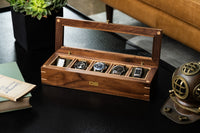Established in 1918 by Swiss watchmaker Georges Schaeren, Mido is a relatively young brand. Perhaps due to its positioning as an entry-level marque within the Swatch Group, its contemporary products often fail to register on the radar of serious collectors. However, certain of its 20th-century models are significant enough to warrant closer examination; whether by virtue of their design, their aesthetics, or their value compared to that of important watches from higher-end brands, they deserve your attention.

Mido founder Georges Schaeren - (Image by Machiine.com)
In addition to the Powerwind Ocean Star ‘Rainbow Diver’ — whose colorful looks were captured in Mido’s modern Ocean Star Decompression Diver 1961 — another standout Mido watch from the post-War period is the Multi-Centerchrono. Unlike standard chronographs that display elapsed time in one or more “totalizers” (or sub-dials) on the main dial, the Multi-Centerchrono features the addition of a central chronograph minutes counter, allowing for the registering of up to 60 minutes. This design frees up real estate for multiple timing scales, which were often added to the dial periphery. (Telemeters, tachymeters, and pulsometers were all seen on Multi-Centerchrono references.)

Closeup of the Multi-Centerchrono's unique dial and complication
Released in 1941, the Multi-Centerchrono took several guises and was said to be particularly popular with pilots. Powering the watch was the Mido Calibre 1300, a hand-wound, column wheel-equipped movement based upon the Valjoux Calibre 23 with 17 jewels and a 48-hour power reserve. Period advertisements show different dial options available in black, silver, or white, depending upon the desired scales. (A tachymeter scale can be used to measure distance traveled, elapsed time, or production output, while a telemeter scale measures distance to an object. A pulsometer is used to measure a patient’s pulse.)

An original ad for the Multi-Centrechrono. (Image by Revolution Watch)
This somewhat unassuming chronograph holds a secret, however, in the form of its own 35mm case. Manufactured by François Borgel — a company founded in 1891 and purchased in 1924 by Taubert & Fils — this early waterproof case was used by the likes of Patek Philippe, Vacheron Constantin, and others in the quest to produce reliable, water-resistant timepieces. Its patented back featured a 10-sided, screw-down system, which dramatically increased water (and dust) resistance, while a patented cork stem seal prevented moisture ingress via the crown. Indeed, Borgel cases were used by Patek on its famed Reference 1463, the maison’s first water-resistant chronograph.

Patek's renowned Reference 1463, its first water-resistant chronograph, used a Borgel case. Note the readily identifiable pushers. - (Image by Phillips)
In addition to the decagonal caseback, Borgel chronograph cases feature a telltale giveaway in the form of their round pushers, which have a ‘sunburst’ design. Take a close look at a Reference 1463 chronograph — a multi-six-figure watch — and you’ll find the same case design, albeit with differences in finishing, caseback, etc. And while the 1463 is no doubt a dressier and more refined watch, the Multi-Centerchrono stands out for other reasons, of which its central chronograph indicator is but one.

Mido Multi-Centerchrono Medical - IN THE SHOP
Take Multi-Centerchrono Medical, for example, which is currently for sale at Analog:Shift: On its beautifully patinated silver dial, you’ll notice the American Medical Association’s symbol, the Caduceus, which is accented by red ‘dart’ indices.
Likely part of a special run — or a pièce unique — made for the Association, this provenance elevates this particular Multi-Centerchrono above other, more common examples. Finished with an acrylic crystal, the aforementioned ‘mushroom’ pushers with Borgel ‘sunburst’ pattern, ‘holey’ lugs, a ‘kite’ handset, and an unsigned crown, it comes paired to a stainless steel multi-link bracelet with an unsigned, ratcheting deployant clasp, as well as an additional Analog:Shift leather strap.

The dial printing on this example remains remarkably crisp.
Produced in the 1950s, the luminescent radium on this stunning vintage chronograph has long since imparted a unique, handsome patina. When combined with its unique complication; important, early waterproof case; and American Medical Association provenance, the results are a winning formula for a rare and attractive piece. Stand it up next to a Borgel-cased chronograph from another marque, and its value quickly becomes apparent. It’s the type of watch that would have Dr. Jones — Junior or Senior — exclaim, “It belongs in a museum!”
So while Mido may continue to fly under the radar, it behooves collectors to look beyond more pedestrian modern fare and into the back catalog, where pieces such as the Multi-Centerchrono are hiding in plain sight. Who knows: Maybe the “museum” in question will be your very own collection!













